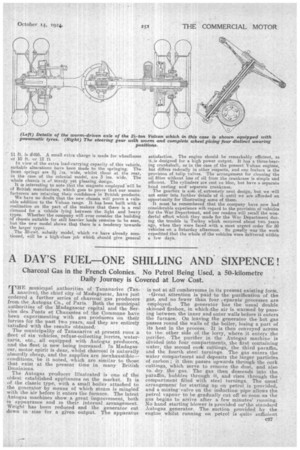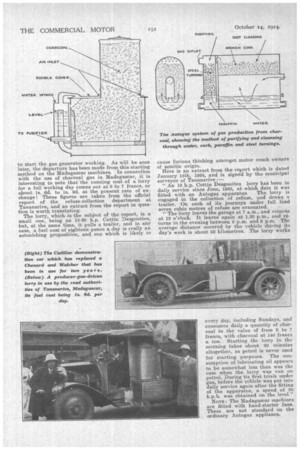A DAY'S FUEL-ONE SHILLING AND SIXPENCE,!
Page 11

Page 12

If you've noticed an error in this article please click here to report it so we can fix it.
Charcoal Gas in the French Colonies. No Petrol Being Used, a 50-kilometre Daily Journey is Covered at Low Cost.
111HE municipal authorities of Tananarive (Tan anarivo), the chief city of Madagascar, have just ordered a further series of charcoal gas producers from the Autogaz Co., of Paris. Both the municipal authorities of the Madagascar capital and the Service des Ponta et Chaussees of the Commune have been experimenting with gas producers on their lorries for the paat two years, and they are entirely satisfied with the results obtained; The municipality of Tananarive at present runs a fleet of six vehicles, refuse-collecting lorries, watercarts, etc., all equipped with Autogaz producers, and the fleet is now being increased. In Madagascar, motor spirit is dear, whilst charcoal is naturally • absurdly cheap, and the supplies are inexhaustible— conditions, be it noted, which are similar to those that exist at the present time in many British Dominions.
The Autogaz producer illustrated is one of the oldest established appliances on the market. It is of the classic type, with a small boiler attached to the generator by means of which steam is mingled with the air before it enters the furnace. The latest Autogaz machines show a great improvement, both in appearance and in their internal arrangement. Weight has been reduced and the generator cut down in size for a given output. The apparatus
is not at all cumbersome in its present existing form. 'Great attention is paid to the purification of the gas, and no fewer than four I eparate processes are employed. The generator has the usual double skinned firebox, in which-the air is warmed by passing between the inner and outer walls before it enters the furnace. On leaving the generator the hot gas passes round the walls of the boiler, losing a part of its heat in the process. It is then conveyed across to the other side of the lorry, where it enters the purifier. The purifier in the Autogaz machine is divided into four compartments, the-first containing water, the second cork cuttings, the third paraffin, and the fourth steel turnings. The gas enters the water compartment and deposits the larger particles of carbon ; it then passes upwards through the cork cuttings, which serve to remove the dust, and also to dry the gas. The gas then descends into the paraffin, bubbles through it, and rises through the compartment filled with steel turnings. The usual arrangement for starting up on petrol is provided, and a mixing valve on the induction pipe allows the petrol vapour to be gradually cut off so soon as the gas begins to arrive after a few minutes' running. No hand starting blower is provided on' the standard Autogaz generator. The suction provided by the engine whilst running on petrol is quite sufficient
to start the gas generator working. As will be seen later, the departure has been made from this starting method on the Madagascar machines. In connection with the use of charcoal gas in Madagascar, it is interesting to note that the running cost of a lorry for a full working day comes out at 6 to 7 francs, or about Is. 6d. to Is. 9d. at the present rate of exchange 1 These figures are taken from the official report of the refuse-collection department at Tananarive, and an extract from the report in question is worth translating.
The lorry, which is the subject of the report, is a small one, being an 18-20 h.p. Cottin Desgouttes, but, at the same time, it pulls a trailer, and in any case, a fuel cost of eighteen pence a day is really an astonishing proposition, and one which is likely to cause furious thinking amongst motor coach owners of semitie origin. Here is an extract from the report which is dated January 14th, 1924, and is signed by the municipal surveyor of Tananarive :— " An 18 h.p. Cottin Desgouttes lorry has been in daily service since June, 1923, at which date it was fitted with an Autogaz apparatus. The lorry is engaged in the collection of refuse, and draws a trailer. On each of its journeys under full load seven cubic metres of refuse are evacuated.
"The lorry leaves the garage at 7 a.m., and returns at 12 o'clock. It leaves again at 1.30 p.m., and returns in the evening between 5 p.m. and 6 p.m. The average distance covered by the vehicle during its day's work is about 50 kilometres. The lorry works every day, including Sundays, and consumes daily a quantity of charcoal to the value of from 6 to 7 francs, with charcoal at 140 francs a ton. Starting the lorry in the morning takes about 20 minutes altogether, as petrol is never used for starting purposes. The consumption of lubricating oil appears to be somewhat less than was the case when the lorry was run on petrol. During its first trials under gas, before the yehicle was put into daily service again after the fitting of the apparatus, a speed of 39 k.p.h. was obtained on the level."
NOTE : The Madagascar machines are fitted with hand-starter fans. These are not standard on the ordinary Autogaz appliance.






























